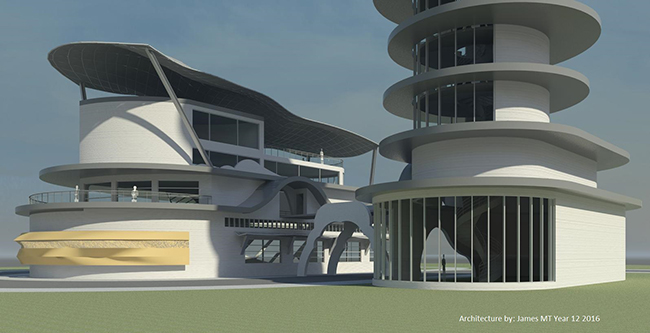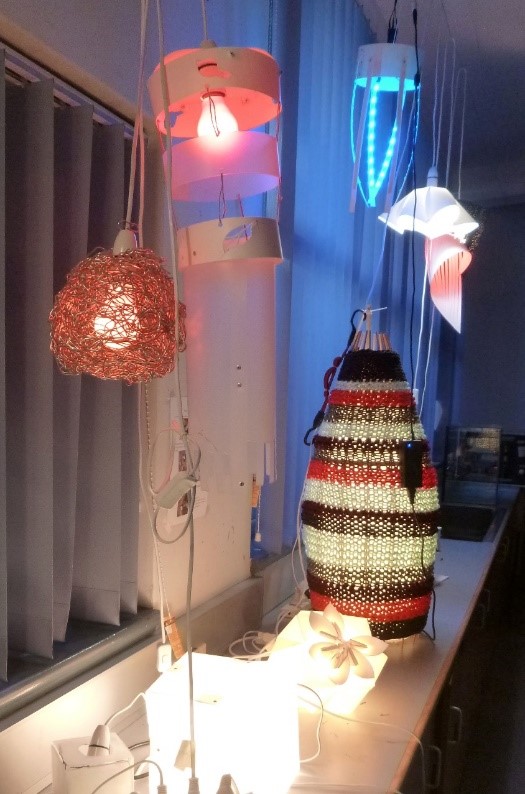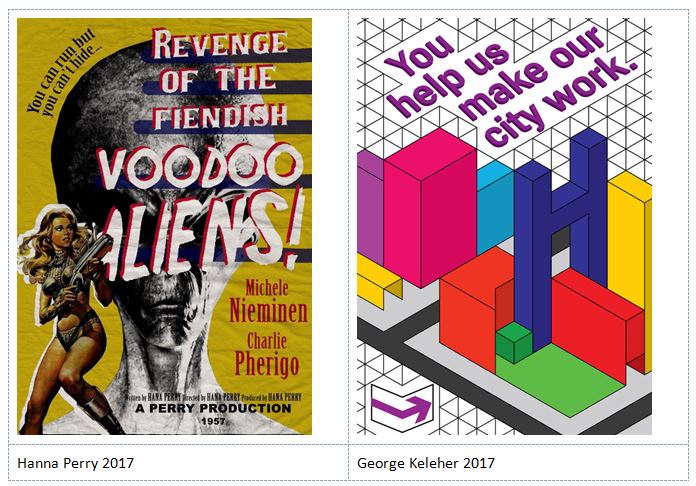Design Technology & Graphics T/A
The Design, Technology and Graphics classes at Narrabundah offer a wide range of topics: Architecture, Graphics, Interior Design, Landscape Design, Industrial Design and Engineering.
Students undertaking this course can study any or all of the streams. Any of them can combine to form a major, major minor or double major.
Architecture

Architecture 1 - (Design Processes a) (0·5)
This unit is designed to introduce students to architectural design standards, concepts, specifications, domestic applications of energy efficiency concepts, the design process, design briefs, Australian drawing standards, presentation and layout methods. Students will be introduced to industry standard Architectural software (Autodesk Revit Architecture) and will build 3 dimensional solutions to introductory exercises. They will learn the fundamentals of building materials and their properties and preliminary sketching techniques.
Architecture 2 - (Architectural Design (1·0)
Students will further develop their design and building information modeling (BIM) skills and investigate different architectural styles while working through a range of design problems. Students will investigate site planning and energy consumption in buildings of various functions. Students will investigate the impact of social demographics and changing human needs in communities, innovation in building materials and processes and economic considerations in building design and construction. Students will develop lighting and rendering skills to be able to colour print their work for display and portfolio.
Architecture 3 - (Design Processes b) (0·5)
This unit provides an opportunity for students to be more self-directed and to physically construct architectural models, produce drawing sets and high quality renderings of their own solutions to an architectural design problem. The theoretical focus will be on developing a deeper knowledge and understanding of contemporary social and cultural aspects involved in the study of architecture and of innovative building materials and processes.
Architecture 4 - (Town Planning and Urban Design a) (0·5)
This unit introduces students to concepts involved in large scale architectural and town planning principles, energy distribution, housing developments, retail outlets, cultural facilities, public space, recreation facilities, transport, airports, and environmental protection. Students will build 3 dimensional solutions to design problems in medium and large scale design projects such as apartment developments, institutional, commercial, cultural buildings, or suburban or small town redevelopment.
Architecture 5 - (Innovation and Design (1·0)
Students will be given the opportunity to negotiate and design and construct their own major project that allows them to demonstrate the full range of skills and knowledge developed over the previous 4 terms of study and to work in-depth in a field of architecture that is of particular interest to them. Non-linear and organic design solutions will be encouraged through conceptual massing techniques. Advanced lighting and rendering techniques will be used to produce exceptional quality graphic displays of student design work.
Architecture 6 - (Architecture Advanced b) (0·5)
This unit provides an opportunity for students and teacher to negotiate a program that covers topics of special interest from advanced Revit modelling and rendering techniques to traditional pictorial drawing and water colour painting of architectural designs. The theoretical focus will be on developing an insight into futuristic trends and concepts involved in the study of architecture and of innovative building materials and processes.
Engineering - (T/A/M) can be studied as a Minor
Engineering Processes and Concepts a 0.5
Students learn about engineering design processes and concepts, and how they are used to develop and optimise solutions to problems, with reference to sustainability, cost and the life cycle of an engineered solution. They explore and investigate existing products, materials and components in response to a design brief. Students design and create working models or prototypes of their solutions.
Engineering Applications (1·0)
The focus this Session is sustainable energy sources for human mobility. We will learn about low carbon emitting energy options and problem-solve two projects: a stored-energy rubber band car and a C02 propelled balsa racer. In both cases we will use engineering and mechanical theory to maximise their performance and increase efficiency/ energy loss to achieve the goals. In the second project we will use computer modelling to represent and test ideas.
In this unit, students learn how engineering design processes, including project management, are applied to solve existing problems. They explore real world problems of increasing complexity requiring project-based solutions. Students use guidelines and a context to apply knowledge of the engineering process and theory, to develop and respond to design briefs.
Engineering Processes and Concepts b 0.5
Students extend the skills they have learnt over the year in a project negotiated with the teacher. Students apply engineering processes, understand underpinning scientific and mathematical principles, develop engineering technology skills and explore the interrelationships between engineering and society. They rely strongly on their creativity, critical thinking and problem solving skills to turn ideas into reality and to develop solutions to problems.

Graphic Design:
In the Graphic Design course, students begin with a basic introduction to graphic design concepts, methods and the design process, before exploring the history and standards of typographic practices and the role of typography in successful graphic design. They complete the course with the opportunity to undertake as much individual and self-directed study as possible, giving them an opportunity to study a particular area of interest within the graphic design course.
Graphic Design Foundation A
An introduction to design fundamentals, which include design elements, the graphic design process, historical and cultural contexts, and production materials. The unit also introduces print media and digital image making technology including the ADOBE Creative Suite.(0∙5)
Graphic Design Applications
Explores in greater depth the design process and introduces strategies for working to a formal design brief. This unit introduces the concepts of iconography and visual literacy: eg. metaphors, symbolism, characterisation, logotypes and signage. Students are presented at least two briefs that offer opportunities for creative response within various media. (1·0)
Graphic Design Foundation B
The design briefs for this unit will focus on building strong illustrative techniques. This unit engages students in more sophisticated concepts of theory and technology including special layout and typography and print industry technologies. (0·5)
Graphic Design Typography A
The first unit in the Major course and focuses of typography in greater depth than previous units. Students will explore the basics of typographic design in relation to individual letterform and singular words, as well as typography for the purposes of corporate identity. (0.5)
Graphic Design - Major Project
A unit that can be studied after the completion of a minor course of Graphic Design that provides an opportunity for students to work as independent designers on a large publishing project. The brief for the project is written by the student themselves with constant supervision by the teacher. (1∙0)
Graphic Design Typography B
The final unit of the Graphic Design Major focuses on exploration of typography and typographic design in further depth. Students will explore typography for text, advertising and publication purposes as well as how typographic trends impact graphic design as a whole. (0.5)
Interior and Landscape Design (A/T/M)
Interior Design 1 and 3 (0∙5)
Students will analyse interior design principles, develop, research and communicate appropriate solutions using computers where applicable. They will analyse features of a plan and produce and present interior designs and elements. Students will analyse historical and cultural influences on interior design and analyse the impact of advancements in technology on interior design
Design 2 - Environmental Design (1∙0)
This unit involves the research, design and graphical presentation of environmental designs and interior design concepts through examining cultural aesthetics, tradition, environmental responsibility and modern materials.



